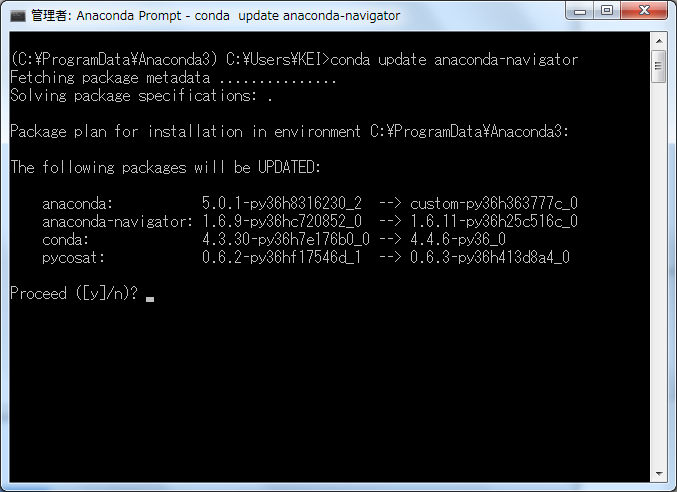
- Anaconda navigator update all packages install#
- Anaconda navigator update all packages update#
- Anaconda navigator update all packages upgrade#
- Anaconda navigator update all packages series#
Anaconda navigator update all packages install#
Now if you want to install any particular package, through pip in conda environment, we can do it like −Ībove we have installed opencv package through pip in conda environment. We can install pip in our existing conda environment by simply giving the command − conda install pipĪnd your screen will be shown an output something like − Method 3 − If the package is not available in our conda environment or through anaconda navigator, we can find and install the package with another package manager like pip. To install a specific package such as opencv into your existing environment “myenv”(in case you have a virtual environment to install project specific packages). Note − It is recommended to install all required packages at once so that all of the dependencies are installed at once. We can install multiple packages at once, such as OpenCV and tensorflow − conda install opencv tensorflow To install specific a specific version of a opencv package − conda install opencv-3.4.2 Method 2 − Another way of installing packages is by the use of terminal or an Anaconda Prompt − conda install opencvĪbove command will install OpenCV package into your current environment.
Anaconda navigator update all packages update#
Let's suppose tensorflow packages are not installed in your computer, I can simply search the required package(like tensorflow), select it and click on apply to install it. conda update -all Level up your programming skills with exercises across 52 languages, and insightful discussion with our dedicated team of welcoming mentors. It is very easy to install any package through anaconda navigator, simply search the required package, select package and click on apply to install it. Go to Environments tab just below the Home tab and from there we can check what all packages are installed and what is not. Once “Ananconda Navigator” is opened, home page will look something like − Method 1 − One common approach is to use the “Anaconda Navigator” to add packages to our anaconda environment.

However, since the base environment is also an environment, the answer applies to both cases in the same way.There are multiple ways by which we can add packages to our existing anaconda environment. Executing conda update -all inside such an environment will update the packages inside this environment. LinuxUbuntu: Open the Dash by clicking the upper left Ubuntu icon, then type terminal. The command run in the base environment will update the packages in this, but usually you should work with virtual environments ( conda create -n myenv and then conda activate myenv). But that is only to hack your way around issues, definitely not the normal-user case!ġ If you actually want to update the packages of your installation, which you usually don’t. Or break the compatibility of the packages (which you usually don’t want!), which is only possible by explicitly invoking an ignore-dependencies and force-command.
Anaconda navigator update all packages upgrade#
So you still cannot upgrade them all by doing the upgrades separately the dependencies are just not satisfiable so earlier or later, an upgrade will downgrade an already upgraded package again. Executing conda update -all inside such an environment will. The command run in the base environment will update the packages in this, but usually you should work with virtual environments ( conda create -n myenv and then conda activate myenv ). ( this is a pedagogical example, of course, but it’s the same in reality, usually just with more complicated dependencies and sub-dependencies) 1 If you actually want to update the packages of your installation, which you usually don’t. So upgrading Y > 5.0 implies downgrading X to < 2.0 and vice versa.

This way conda does also search in this places for available packages.Ĭonsidering your update: You can upgrade them each separately, but doing so will not only include an upgrade but also a downgrade of another package as well. It’s rather a hack.Ī safe way you can try is to add conda-forge as a channel when upgrading (add -c conda-forge as a flag) or any other channel you find that contains your package if you really need this new version. If you do that, do it as a last resort and after all packages have been installed with conda. But be aware that pip also installs packages if dependency conflicts exist and that it usually breaks your conda environment in the sense that you cannot reliably install with conda anymore. It is possible to install with pip, since more packages are available in pip. To add: maybe it could work but a newer version of X working with Y > 5.0 is not available in conda. That’s why you ‘cannot’ upgrade them all. Anaconda comes with a suite of graphical tools called Anaconda Navigator.You can start Anaconda Navigator by opening it from your application launcher.Anaconda Navigator GUI. Conda usually warns very explicitly if they occur. Anaconda comes with a suite of graphical tools called Anaconda Navigator.You can start Anaconda Navigator by opening it from your application launcher. Dependency conflictsīut it is possible that there are dependency conflicts (which prevent a further upgrade).
Anaconda navigator update all packages series#
Conda always tries to upgrade the packages to the newest version in the series (say Python 2.x or 3.x).


 0 kommentar(er)
0 kommentar(er)
